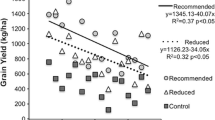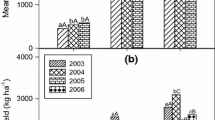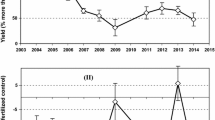Abstract
Field experiments were designed to investigate the effectiveness of integrated soil fertility management (ISFM), comparing fertilizer use efficiency and its impact on millet, cultivated close to the homestead (“infields”) and away from the homestead (“outfields”). Millet yields and response to N (0, 30, and 60 kg ha−1) and P (0, 15, and 30 kg ha−1) were determined on nine infields and nine outfields over a period of 3 years (from 1999 to 2001) in the southern Sahel of Niger. Rainfall was 650, 470, and 370 mm during the three successive years, interaction between decreasing rainfall and millet yield performance was also analyzed. While soil organic carbon (1.5 g kg−1 on outfields and 1.6 g kg−1 on infields) and pH-H2O (4.8 on outfields and 5.1 on infields) were comparable, total-N, plant available P (measured as P-Olsen and P-Bray), and exchangeable Ca, K, and Mg levels were higher on infields as compared to outfields. Without fertilizer, average grain yield (GY) and stover yield obtained on infields were three times as high as on outfields. GY across years and fertilizer treatments was higher on infields as compared to outfields (P < 0.001). Average yield was 800 kg ha−1 on outfields and 1,360 kg ha−1 on infields (P < 0.001). On outfields, average GY was stagnant over the 3-year experimental period. Despite declining rainfall, millet GY across all treatments gradually increased over time on infields (P < 0.001). P fertilization alone resulted on both field types to steadily and substantial yield increases while yield response to N fertilization was only obvious when fertilizer P was applied. With no fertilizer applied, N uptake on infields (19 kg N ha−1) was more than twice as high as on outfields (7 kg ha−1), and P uptake was four times higher on infields (3 kg ha−1) than on outfields (0.8 kg ha−1). Indigenous soil N supply was on average 24 kg N ha−1 on outfields and 46 kg N ha−1 on infields. Average value for indigenous soil P supply was 4 kg P ha−1 on infields and 2 kg ha−1 on outfields. Apparent recovery of fertilizer N applied varied considerably among treatments and ranged from 17 to 23% on outfields and 34 to 37% on infields (P < 0.001). Average apparent recovery of fertilizer P applied was significantly higher (P < 0.001) on infields (31%) than on outfields (18%) over the 3-year growing period, illustrating ISFM-induced positive effect on millet nutrient N and P use. Results indicate higher inherent soil fertility, underline ISFM-induced drought tolerance of soils on infields as compared to outfields, and highlight the crucial role of fertilizer P (especially on outfields) for millet production. These call for site-specific nutrient management and support, even under low rainfall conditions, the potential value of fertile infields for efficient and productive external input use and sustainable millet production in West African Sahel.




Similar content being viewed by others
References
Affholder F (1995) Effect of organic matter input on the water balance and yield of millet under tropical dryland condition. Field Crops Res 41:109–121
Bationo A, Ntare BR (2000) Rotation and nitrogen fertilizer effects on pearl millet, cowpea and groundnut yield and soil chemical properties in a sandy soil in the semi-arid tropics, West Africa. J Agric Sci Camb 134:277–284
Bationo A, Mokwunye AU, Baanante CA (1985) Agronomic evaluation of alternative fertilizer sources in Niger. In: Ohm HW, Nagy JG (eds) Appropriate technologies for farmers in semi-arid West Africa. International Programme in Agriculture, Perdue University, West Lafayette, IN
Bationo A, Christianson BC, Baethgen WE, Mokwunye AU (1992) A farm level evaluation of nitrogen and phosphorus fertilizer use and planting density for pearl millet production in Niger. Fertil Res 29:117–125
Breman H (1990) No sustainability without external inputs. In: Beyond adjustment: sub-Saharan Africa. Africa Seminar. Maastricht, The Netherlands, pp 124–134
Breman H, Rob Groot JJ, van Keulen H (2001) Resource limitation in Sahelian agriculture. Glob Environ Change 11:59–68
Buerkert A, Hiernaux P (1998) Nutrients in the West African Sudano-Sahelian zone: losses, transfers and role of external inputs. J Plant Nutr Soil Sci 161:365–383
Buerkert A, Bationo A, Dossa K (2000) Mechanisms of residue mulch-induced cereal growth increases in West Africa. Soil Sci Soc Am J 64:346–358
Esse PC, Buerkert A, Hiernaux P, Assa A (2001) Decomposition of and nutrient release from ruminant manure on acid sandy soils in the Sahelian zone of Niger, West Africa. Agric Ecosyst Environ 83:55–63
Fofana B, Tamelokpo A, Wopereis MCS, Breman H, Dzotsi K, Carsky RJ (2005) Nitrogen use efficiency by maize as affected by a mucuna short fallow and P application in the coastal savanna of West Africa. Nutr Cycling Agroecosyst 71:227–237
Gomez KA, Gomez AA (1984) Statistical procedures for agricultural research. An International Rice Research Institute Book, Wiley, Brisbane, Australia, pp 187–233
Hafner H, George E, Bationo A, Marschner H (1993) Effect of crop residues on root growth and phosphorus acquisition of pearl millet in an acid sandy soil in Niger. Plant Soil 150:117–127
International Institute of Tropical Agriculture (IITA) (1982) Automated and semi-automated methods for soil and plant analysis. Manual series 7. IITA, Ibadan, Nigeria
Keatinge JDH, Breman H, Manyong V, Vanlauwe B, Wendt J (2001) Sustaining soil fertility in West Africa in the face of rapidly increasing pressure for agricultural intensification. In: Tian G, Ishida I, Keatinge D (eds) Sustaining soil fertility in West Africa. SSSA Special Publication No. 58, SSSA and ASA, Madison, WI, USA, pp 1–21
Manu A, Bationo A, Geiger SC (1991) The fertility status of millet producing soils of West Africa with emphasis on phosphorus. Soil Sci Soc Am J 152:315–320
Mapfumo P, Giller KE (2001) Soil Fertility management strategies and practices by smallholder farmers in semi-arid areas of Zimbabwe. International Crops Research Institute for the Semi-Arid Tropic and Food and Agriculture Organization of the United Nations, Rome, Italy, 53p
Marschner H (1995) Mineral nutrition of higher plants. Academic, London, UK
McIntire J, Bourzat D, Pingali P (1992) Crop-livestock interaction in Sub-Saharan Africa. The world bank, world bank, regional and sectoral studies, Washington, DC, p 24
Maurya PR, Lal R (1981) Effect of different mulch materials on soil properties and the root growth and yield of maize (Zea mays, L.) and cowpea (Vigna unguiculata). Field Crops Res 4:33–45
Palm CA (1995) Contribution of agroforestry tree to nutrient requirements of intercropped plants. Agroforor Syst 30:105–124
Penning de Vries FWT, Ditèye MA (1991) La Productivité des Pâturages Saheliens. Pudoc, Wageningen, The Netherlands
Pichot J, Roche P (1972) Le phosphore dans les sols tropicaux. Agron Trop 27:939–965
Pieri C (1986) Fertilisation des cultures vivrières et fertilité des sols en agriculture paysanne sub-saharienne. Agron Trop 40:1–20
Pieri C (1989) Fertilité des terres de savanes. Bilan de trente ans de recherche et de développement agricole au Sud du Sahara. Ministère de la Coopération et du Développement, CIRAD-IRAT, Paris, 444p
Powell JM, Coulibaly T (1995) The ecological sustainability of red meat production in Mali: nitrogen balance of rangeland and crop in four production systems. Report to Projet de Gestion des Ressources Naturelles (PGRN), Bamako, Mali, 41pp
Powell JM, Williams TO (1993) Livestock, nutrient cycling and sustainable agriculture in the West African Sahel. Gatekeeper series no. 37. International Institute for Environment and Development, Sustainable Agriculture Programme, London, 15pp
Prudencio YC (1983) A village study of soil fertility management and food crop production in Upper-Volta. Technical and economic analysis. Ph.D. thesis, University of Arizona, USA
Samaké O (2003) Integrated crop management strategies in Sahelian land use systems to improve agricultural productivity and sustainability: a case study in Mali. Ph.D. thesis, University of Wageningen, The Netherlands
Sédogo PM (1993) Evolution des sols ferrugineux lessivés sous culture: incidence des modes de gestion sur la fertilité. Ph.D. thesis, University of Abidjan, Ivory Coast, 343pp
Soil Survey Staff (1975) Soil taxonomy. A basic system on soil classification for making and interpreting soil surveys, vol 436. Soil Conservation Service, US Department of Agriculture, Washington, DC, USA
Wopereis MCS, Tamelokpo A, Ezui K, Gnakpénou D, Fofana B, Breman H (2005) Mineral fertilizer management of maize on farmer fields differing in organic inputs in the West African savanna. Field Crops Res 96:355–362
Acknowledgments
Financial support for the research reported here was provided by grants from the International Fund for Agricultural Development (IFAD), the US Agency for International Development (USAID), and The Netherlands’ Ministry for Development Cooperation (DGIS).
Author information
Authors and Affiliations
Corresponding author
Rights and permissions
About this article
Cite this article
Fofana, B., Wopereis, M.C.S., Bationo, A. et al. Millet nutrient use efficiency as affected by natural soil fertility, mineral fertilizer use and rainfall in the West African Sahel. Nutr Cycl Agroecosyst 81, 25–36 (2008). https://doi.org/10.1007/s10705-007-9146-y
Received:
Accepted:
Published:
Issue Date:
DOI: https://doi.org/10.1007/s10705-007-9146-y




